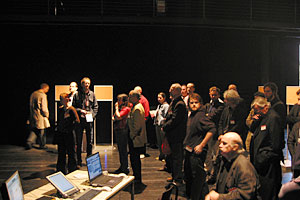|
||||||||||||
| back |
The visitors to the Forum Neues Musiktheater of the Staatsoper Stuttgart move quietly through the auditorium, listening intently to a female singer who seems to be physically real and standing in the room—but she cannot be seen. Some of the listeners have already found her. She appears to be standing about a meter in front of the loudspeakers. What sounds like an actual singer is really an acoustic hologram, or “holophone.” The Forum Neues Musiktheater presented this new technology over the weekend in the context of a workshop at its premises in the Römerkastell in Bad Cannstatt, together with the firm sonicEmotion from Zurich and IRCAM (Institut de Recherche et de Coordination Acoustique/Musique) from Paris, and in cooperation with IRT (Institut für Rundfunktechnik) and VDT (Verband deutscher Tontechniker). “Wave field synthesis” is the technical term for this technology, and it is one of the newest developments in the field of audio engineering. The three-dimensional illusion is made possible by a large number of loudspeakers set very close together. For the workshop, our colleagues from sonicEmotion and IRCAM installed a number of flat loudspeakers, each of them only a few centimeters thick, for a total of eighty channels. Considerably more than one is used to from one’s stereo. For the time being, however, wave field synthesis does not wish to be the new sound in people’s living rooms, but above all to improve the sound at theaters, events, movie theaters, and the like. Dr. Renato Pellegrini, the managing director of sonicEmotion, explains: “With wave field synthesis, it is possible to solve many amplification problems elegantly, especially when a large audience is present. When you sit in a concert where a conventional sound system is being used, you sometimes hear that you are sitting close to a loudspeaker. It is not a pleasant effect, because what you actually want to do, of course, is focus on the musicians. With wave field synthesis, you can virtually place a sound source on the stage. The listener can no longer tell whether the sound is coming directly from the musician or whether it is emanating from the electronic sound system. Furthermore, wave field synthesis also opens up entirely new creative possibilities. This technology makes it possible to create entirely new acoustic spaces. The listener becomes immersed in a virtual reality, which is impossible with conventional stereo reproduction.” The visitors were able to discover for themselves just how powerful the capabilities of this “holophone” were from a wide variety of examples, from people on stage simply speaking, through combinations of music and noises, all the way to radio plays. The composer Philippe Schoeller (IRCAM) presented his work Vertigo for the first time using wave field synthesis. The technology is made possible by a networked rendering of audio data on multiple computers. A new networking technology makes it possible to control the reproduction on all eighty channels simultaneously. To integrate the loudspeakers into the environment inconspicuously, flat loudspeakers may be used, whose form and color may be adapted to the interior design—an important consideration, especially where historically protected spaces are concerned. It should be noted, however, that this flat loudspeaker technology is not uniquely linked to wave field synthesis. It can even be used in conventional stereo reproduction. Wave field synthesis was invented in the 1980s at the Technische Universität in Delft, the Netherlands. Its physical bases, however, are quite a bit older. As early as the seventeenth century, the physicist Christian Huygens recognized (to oversimplify) that every point of a wave front may in turn be regarded as the origin of another, conical wave front. In physical terms, the wave front of the primary source is “synthesized” by the envelope of the wave fronts of the secondary sources. For wave field synthesis, this means, in practice, that we can simulate the propagation of a sound source by feeding the appropriate audio signals to a large number of loudspeakers (secondary sources) set very close together. For the direct sound, one controls the signal level and time delay of the incoming source signals at every loudspeaker. The resulting sum is a wave that matches that of the original sound source in form. Various institutes and companies have worked on this technology in recent years. Finally, last year wave field synthesis was able to leave the research phase, and it is now available to users. “For the Forum Neues Musiktheater, wave field synthesis represents a serious and innovative factor in its effort to integrate new media into the theater,” Klaus Zehelein, the general director of the Stuttgarter Staatsoper, said in his opening address at the weekend workshop. The Forum regards itself as a laboratory where research, development, and practice are combined. Since its creation, it has not only been committed to new, experimental forms of music theater; it has also focused time and again on incorporating new technologies into the various aspects of musical and theatrical realization. Judging by the numbers of interested visitors who took part in this workshop from the fields of theater, events, radio, the sciences, industry, art, and architecture and their impressions, one may safely predict that in future, wave field synthesis will find a broad range of additional applications, not only in the theater world. » WAVE FIELD SYNTHESIS Photos » SONICEMOTION Homepage » IRCAM Homepage » IRT Homepage » VDT Homepage |
|||||||||||
|
Imprint |
|
